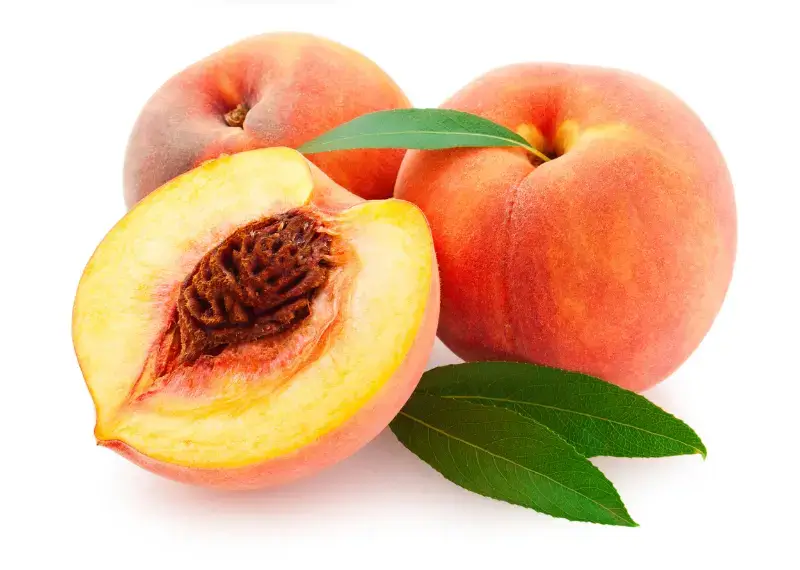Can Dogs Eat Peaches? Complete Guide for Pet Parents
Picture this: It’s a warm summer afternoon, and you’re enjoying a juicy, sweet peach. Your furry companion sits nearby, gazing up at you with those irresistible puppy eyes, clearly hoping for a taste. But before you share your snack, you pause and wonder—is it actually safe for dogs to eat peaches?
The good news? Yes, dogs can absolutely enjoy peaches as an occasional treat! However, like many human foods, there are some important safety guidelines and precautions every pet parent should know before adding this fuzzy fruit to their dog’s diet. Let’s dive into everything you need to know about feeding peaches to your four-legged friend.
Table of Contents
What Makes Peaches a Healthy Treat for Dogs?
Peaches aren’t just delicious—they’re packed with nutrients that can benefit your dog’s health when served properly. This stone fruit is loaded with essential vitamins and minerals that support your pet’s overall well-being in multiple ways.
The vitamin content in peaches is particularly impressive. They contain vitamin A, which promotes healthy vision and skin, along with vitamin C that strengthens your dog’s immune system and acts as a powerful antioxidant. You’ll also find vitamin E, which supports skin and coat health, and vitamin K, essential for proper blood clotting and bone health.
Beyond vitamins, peaches offer valuable minerals including copper for healthy blood cells, zinc for immune function and wound healing, magnesium for muscle and nerve function, phosphorus for strong bones and teeth, and potassium that helps regulate fluid balance and supports heart health. The fiber content in peaches aids digestion and keeps your dog’s gut healthy, while the high water content provides extra hydration on hot days.
Perhaps best of all, peaches are relatively low in calories and fat, making them an excellent choice for weight-conscious pups who still deserve the occasional treat. The natural antioxidants in peaches help fight inflammation and protect your dog’s cells from damage caused by free radicals.
The Amazing Health Benefits Your Dog Gets from Peaches
When you feed peaches to your dog correctly, you’re offering more than just a tasty snack—you’re providing real health benefits that can enhance their quality of life. Let’s explore what makes this fruit so beneficial for our canine companions.
Stronger Immune Defense: The combination of vitamins A and C, along with powerful antioxidants, works together to bolster your dog’s immune system. This helps their body fight off infections more effectively and protects their cells from oxidative stress and environmental damage.
Better Digestive Health: The dietary fiber found in peaches supports a healthy digestive tract, helping to prevent constipation and promote regular, healthy bowel movements. If your dog occasionally struggles with digestive issues, a small amount of peach might offer gentle relief.
Improved Hydration: With their high water content, peaches can be an excellent supplemental hydration source, especially during warmer months when dogs need extra fluids. This makes them a refreshing treat after playtime or a walk on a sunny day.
Natural Dental Support: While peaches should never replace proper dental care, chewing fresh peach slices can provide some minor dental benefits by helping to scrape away plaque buildup. The texture of the fruit’s flesh offers a gentle cleaning action as your dog chews.
Weight-Friendly Treat Option: For dogs who need to watch their weight but still deserve treats, peaches offer a low-calorie alternative to many commercial dog treats. This allows you to reward your pet without significantly impacting their daily calorie intake, as long as portions remain appropriate.
Important Risks and Safety Concerns Every Dog Owner Must Know
While peaches offer numerous benefits, there are serious safety concerns that every responsible pet owner needs to understand before feeding this fruit to their dog. Awareness of these risks could literally save your dog’s life.
The Peach Pit Danger: This is the most critical warning—never, under any circumstances, allow your dog to eat a peach pit. The pit contains amygdalin, a compound that breaks down into cyanide when digested. Cyanide is extremely toxic to dogs and can cause symptoms like vomiting, difficulty breathing, dilated pupils, bright red gums, shock, and, in severe cases, death. Beyond the toxicity issue, peach pits also pose serious choking hazards and can cause intestinal blockages that may require emergency surgery.
Sugar Content Concerns: While natural, the sugar in peaches can be problematic for certain dogs. If your pet has diabetes, is overweight, or is prone to weight gain, you should either avoid peaches entirely or only offer tiny amounts very occasionally. Too much sugar can affect blood glucose levels and contribute to obesity and related health problems.
Digestive Upset Potential: Even though peaches can support digestion in small amounts, feeding too much can backfire. Excessive consumption may lead to diarrhea, vomiting, stomach pain, or general gastrointestinal discomfort. Your dog’s digestive system needs time to adapt to new foods.
Avoid Processed Peach Products: Never feed your dog canned peaches, peaches packed in syrup, or any processed peach products. These contain excessive amounts of added sugar, artificial sweeteners like xylitol (which is extremely toxic to dogs), and preservatives that can harm your pet’s health.
Potential Allergic Reactions: Although relatively uncommon, some dogs may develop allergies or sensitivities to peaches. Watch carefully for symptoms such as itching, hives, facial swelling, difficulty breathing, or excessive scratching. If you notice any of these signs, stop feeding peaches immediately and consult your veterinarian.

How to Safely Prepare and Serve Peaches to Your Dog
Proper preparation is essential when offering peaches to your dog. Following these guidelines will help ensure your pet enjoys this treat safely without any negative consequences.
Start by selecting only ripe, fresh peaches for your dog. Wash the peach thoroughly to remove any pesticides, dirt, or bacteria from the skin. While the fuzzy skin is technically safe for dogs to eat, some pets may find it harder to digest, so you can peel it if you prefer.
The most crucial step is completely removing the pit, stem, and any leaves. Cut the peach in half, remove the entire pit, and double-check that no pit fragments remain. Even small pieces of the pit can be dangerous, so be thorough in your inspection.
Cut the peach flesh into small, bite-sized pieces appropriate for your dog’s size. Small dogs should receive tiny cubes to prevent choking, while larger dogs can handle slightly bigger pieces. Always supervise your dog while they’re eating a peach to ensure they chew properly and don’t try to swallow large chunks.
When introducing peaches for the first time, start with just one or two small pieces and wait 24-48 hours to observe how your dog reacts. Look for any signs of digestive upset, allergic reactions, or unusual behavior. If everything seems fine, you can offer slightly more on subsequent occasions.
Remember the golden “10% rule” for treats: all treats combined, including peaches, should make up no more than 10% of your dog’s total daily caloric intake. For a small dog, this might mean just one or two small cubes of peach, while a larger dog might be able to enjoy a few more pieces. When in doubt, less is always better than more.
Peaches vs. Other Dog-Friendly Fruits: How Do They Compare?
To help you understand where peaches fit into your dog’s treat options, let’s compare them with other popular fruits that are safe for canine consumption.
| Feature | Peaches | Apples | Bananas | Blueberries |
|---|---|---|---|---|
| Main Vitamins | A, C, E, K | A, C | C, B6 | C, K |
| Fiber Content | High | Moderate | Moderate | High |
| Sugar Level | Moderate-High | Moderate | High | Low |
| Toxic Parts | Pit (cyanide) | Seeds (trace cyanide) | None known | None known |
| Digestive Benefits | Excellent | Excellent | Excellent | Excellent |
| Hydration Value | High water content | High water content | Moderate water content | High water content |
| Choking Concerns | Pit is major hazard | Seeds and core | Minimal risk | Very low risk |
| Preparation Required | Remove pit completely, cut into small pieces | Remove core and all seeds, slice thinly | Cut into appropriate sized pieces | Can be served whole (in moderation) |
| Best For | Immune support, hydration | Dental health, fiber | Quick energy, potassium | Antioxidants, low-calorie option |
This comparison shows that while peaches are nutritious, each fruit offers unique benefits. Blueberries might be the safest choice due to no toxic parts and low sugar, while bananas provide quick energy but with higher sugar content. Apples offer similar preparation challenges to peaches with their seeds. The key is variety and moderation—rotating different safe fruits keeps treats interesting while providing diverse nutritional benefits.
Recognizing and Responding to Peach-Related Problems
Even with proper preparation, it’s important to know how to recognize if something goes wrong after your dog eats peaches. Quick action can make a significant difference in outcomes.
If your dog accidentally swallows a peach pit, contact your veterinarian or an emergency animal hospital immediately. Don’t wait for symptoms to appear—peach pit ingestion is a true emergency. Symptoms of cyanide poisoning can include excessive drooling, vomiting, diarrhea, difficulty breathing, dilated pupils, bright red gums, weakness, collapse, or seizures.
For less severe reactions, watch for signs of digestive upset such as vomiting, diarrhea, loss of appetite, lethargy, abdominal pain, or excessive gas. If these symptoms are mild and your dog seems otherwise okay, you might wait a few hours while ensuring they have access to fresh water. However, if symptoms persist beyond 12-24 hours or worsen, veterinary attention is necessary.
Allergic reactions require immediate attention, especially if you notice facial swelling, hives, difficulty breathing, or excessive scratching and itching. These symptoms can escalate quickly, so don’t hesitate to seek emergency care.
Prevention is always better than treatment. By carefully following preparation guidelines, supervising your dog during treats, and offering appropriate portions, you can minimize the risk of any problems occurring in the first place.
Conclusion: Sweet Treats for Happy, Healthy Dogs
Peaches can absolutely be a wonderful, nutritious treat for your beloved dog when prepared and served correctly. Their impressive nutritional profile—rich in vitamins A, C, E, and K, loaded with beneficial minerals, and packed with fiber and antioxidants—makes them a health-boosting snack option that goes beyond empty calories.
The key to safely incorporating peaches into your dog’s diet lies in careful preparation and mindful moderation. Always remove the pit, stem, and leaves completely, cut the fruit into appropriately sized pieces, and limit portions to no more than 10% of your dog’s daily caloric intake. Start slowly when introducing this fruit, watching carefully for any adverse reactions.
While the benefits are real—from immune system support to better digestion and improved hydration—the risks are equally important to remember. Peach pits pose serious toxicity and choking dangers, while the natural sugar content may not suit all dogs, particularly those with diabetes or weight concerns.
By following the guidelines outlined in this article, you can confidently share this delicious summer fruit with your furry friend, knowing you’re providing both a tasty treat and valuable nutrients. Your dog will appreciate the sweet, juicy flavor, and you’ll have peace of mind knowing you’re treating them safely and responsibly.
Remember, every dog is unique, and what works well for one may not suit another. When in doubt, consult with your veterinarian about whether peaches are appropriate for your specific pet’s health needs and dietary requirements. Here’s to happy, healthy dogs enjoying safe, delicious treats!
Frequently Asked Questions
Are peaches safe for all dogs?
Can dogs eat peach pits?
No. Peach pits contain cyanide and pose choking and blockage risks. If ingested, contact a vet immediately.
How much peach can I give my dog?
Follow the “10% rule”: treats, including peaches, should be no more than 10% of your dog’s daily calorie intake. Small dogs might only have 1-2 peach cubes; larger dogs can have a bit more.
What are the health benefits of peaches for dogs?
Peaches provide vitamins A, C, antioxidants, fiber, and hydration benefits. They enhance immunity, digestion, and overall health in moderation.









